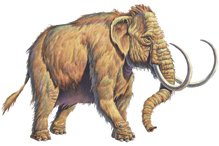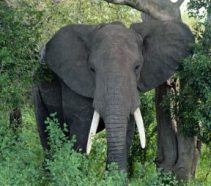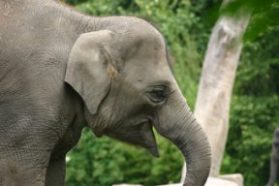From Mammoth to Modern Elephant
The Asian elephant appears to be the closest living relative of the woolly mammoth, now extinct.
Share this:
- Share via email (Opens in new window) Email
- Click to share on Facebook (Opens in new window) Facebook
- Click to share on X (Opens in new window) X
- Click to share on Pinterest (Opens in new window) Pinterest
- Click to share on Reddit (Opens in new window) Reddit
- Share to Google Classroom (Opens in new window) Google Classroom
- Click to print (Opens in new window) Print
By Emily Sohn
Thousands of years ago, an elephant-like creature called the woolly mammoth roamed Earth. Except for fossilized bones and remains found trapped in ice, it’s now gone. Scientists have long wondered whether the extinct mammoth is more closely related to today’s African elephant or Asian elephant.
Modern elephants and woolly mammoths share a common ancestor that lived about 6 million years ago. Exactly how and when the species split over time, though, hasn’t been clear. Now, researchers are using modern techniques to piece together ancient elephant history.
 |
|
The woolly mammoth appears to be more closely related to the Asian elephant than to the African elephant. |
| J. Tucciarone |
From looking at fossilized bones and other features, scientists had proposed that woolly mammoths are more closely related to Asian elephants than to African elephants. Tiny pieces of evidence from the genetic material DNA, on the other hand, hinted at the opposite conclusion.
Because DNA is often the most reliable way to trace evolutionary links, a team led by scientists at the Max Planck Institute for Evolutionary Anthropology in Leipzig, Germany, set out to document part of the mammoth genome, which is a map of the creature’s DNA. Only recently has technology become available to recreate a genome based on old, damaged DNA.
 |
|
An African elephant. The African elephant has larger ears and a larger forehead than the Asian elephant does. Both males and females have tusks. Its back droops in the middle. |
| PhotoDisc |
The scientists first took just 200 milligrams of bone from a mammoth that had lived 12,000 years ago in northeastern Siberia. Then, they used a chemical reaction to make many copies of whatever pieces remained of the mammoth’s DNA. Many of the pieces overlapped, so the scientists were able to put them together, like a jigsaw puzzle, into a complete whole.
In this study, the researchers focused on a type of DNA called mitochondrial DNA. It’s a ring-shaped structure found inside a cell part called the mitochondrion. Analyses showed that the modern Asian elephant shares 95.8 percent of its mitochondrial DNA with the woolly mammoth. The modern African elephant has a slightly smaller overlap, sharing about 95.5 percent of its mitochondrial DNA with the woolly mammoth.
The difference suggests that African elephants were the first modern species to split from the main branch of the elephant family tree. Asian elephants and woolly mammoths branched off about 440,000 years later, the scientists say. In other words, Asian elephants are more closely related to mammoths than are African elephants.
 |
|
An Asian elephant. The Asian elephant has smaller ears and a smaller forehead (with two big bumps) than the African elephant does. Usually only males have tusks. Its back arches up in the middle. |
| iStockphoto |
The findings should be weighed cautiously, some scientists warn, because looking only at mitochondrial DNA can be misleading. Instead, a group of researchers in Canada is using new high-speed machines to analyze every piece of DNA in the nucleus of a mammoth’s cell.
Strands of DNA in the cell nucleus are millions of times longer than those in the mitochondrion, so the project may take a couple of years. When it’s done, though, we may finally have a clear picture of the elephant family tree.—E. Sohn
Going Deeper:
Perkins, Sid. 2005. Mammoth findings: Asian elephant is closest living kin. Science News 168(Dec. 24&31):403. Available at http://www.sciencenews.org/articles/20051224/fob1.asp .
You can learn more about the woolly mammoth at school.discovery.com/schooladventures/woollymammoth/ (Discovery Channel) and www.beringia.com/02/02maina2.html (Yukon Beringia Interpretive Centre).







